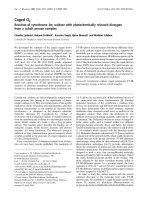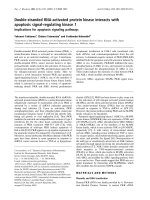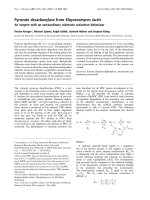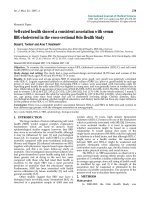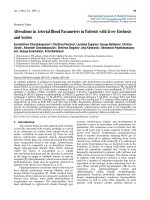Báo cáo y học: "Rapidly progressive Bronchiolitis Obliterans Organising Pneumonia presenting with pneumothorax, persistent air leak, acute respiratory distress syndrome and multi-organ dysfunction: a case report" pdf
Bạn đang xem bản rút gọn của tài liệu. Xem và tải ngay bản đầy đủ của tài liệu tại đây (158.03 KB, 3 trang )
BioMed Central
Page 1 of 3
(page number not for citation purposes)
Journal of Medical Case Reports
Open Access
Case report
Rapidly progressive Bronchiolitis Obliterans Organising Pneumonia
presenting with pneumothorax, persistent air leak, acute
respiratory distress syndrome and multi-organ dysfunction: a case
report
Indranil Chakravorty*
1
, William LG Oldfield
2
and Carlos MH Gómez
2
Address:
1
Department of Respiratory Medicine, Lister Hospital, Beds & Herts Postgraduate Medical School, Stevenage, UK and
2
Adult Intensive
Care Unit, St Mary's Hospital, London, UK
Email: Indranil Chakravorty* - ; William LG Oldfield - ;
Carlos MH Gómez -
* Corresponding author
Abstract
Introduction: Bronchiolitis Obliterans Organising Pneumonia (BOOP) may often present initially
as a recurrent spontaneous pneumothorax and then develop multi-system complications.
Case presentation: A 17-year-old boy presented with a pneumothorax, which developed into
rapidly progressive Bronchiolitis Obliterans Organising Pneumonia (BOOP). He developed multi-
organ dysfunction (including adult respiratory distress syndrome, oliguric renal failure, acute
coronary syndrome, cardiac failure and a right atrial thrombus) which necessitated prolonged
intensive care. Diagnosis was confirmed on open lung biopsy and he responded well to treatment
with corticosteroids.
Conclusion: BOOP is exquisitely sensitive to oral corticosteroids but if the diagnosis is not
considered in such patients and appropriate treatment instituted early, BOOP may often lead to
prolonged hospital admission with considerable morbidity.
Introduction
Bronchiolitis Obliterans Organising Pneumonia
(BOOP) is a clinico-pathological entity [1] characterised
histologically by polypoid masses of granulation tissue in
the lumen of small airways, alveolar ducts and alveoli co-
existing with fibrosis [2]. Its distribution is patchy, with
preservation of background architecture [1]. Lung func-
tion tests demonstrate impaired diffusion capacity with a
restrictive picture [3] while the radiological appearance is
of patchy consolidation and alveolar infiltrates in a peri-
bronchiolar or pleural distribution [4]. We report on what
we believe to be the first case of BOOP associated with
persistent air leak, multiple organ failure and acute coro-
nary syndrome.
Case presentation
A 17-year-old Asian man presented with a spontaneous
pneumothorax, which was treated initially by needle aspi-
ration. It recurred within a week with complete right-sided
pneumothorax requiring water-sealed intercostal drain-
age. The air leak persisted after one week and the patient
developed pyrexia with associated neutrophilia and raised
serum inflammatory markers. A chest radiograph showed
a hydro-pneumothorax and culture of the pleural fluid
Published: 6 May 2008
Journal of Medical Case Reports 2008, 2:145 doi:10.1186/1752-1947-2-145
Received: 15 June 2007
Accepted: 6 May 2008
This article is available from: />© 2008 Chakravorty et al; licensee BioMed Central Ltd.
This is an Open Access article distributed under the terms of the Creative Commons Attribution License ( />),
which permits unrestricted use, distribution, and reproduction in any medium, provided the original work is properly cited.
Journal of Medical Case Reports 2008, 2:145 />Page 2 of 3
(page number not for citation purposes)
grew Pseudomonas aeruginosa and Methicillin-resistant Sta-
phylococcus aureus (MRSA). He was treated with intrave-
nous Piperacillin-Tazobactam resulting in a full clinic-
radiological recovery.
A week later his fever returned and repeat chest radiograph
showed right middle and lower lobe consolidation associ-
ated with recurrent hydro-pneumothorax. A new intercos-
tal drain was inserted and he was intubated and ventilated
due to the rapid onset of severe respiratory distress. Com-
puted tomogram (CT scan) of the chest confirmed bilat-
eral patchy consolidation in association with widespread
ground-glass opacities, sub-pleural cavitation and bilat-
eral pleural effusions. He underwent an open thoracot-
omy, which did not reveal any macroscopic evidence of an
organised or loculated empyema.
Postoperatively he developed multi-organ dysfunction
with oliguric renal failure, prolonged mechanical ventila-
tion, consumption coagulopathy, elevated amino-
transaminases and an anteroseptal myocardial infarction
with moderate left ventricular systolic dysfunction as evi-
denced by transoesophageal echocardiography (TOE) and
raised troponin I.
Multiple sampling of blood, urine and bronchoscopic lav-
age fluid for culture did not show any new bacterial, fun-
gal or viral infection and the leukocyte count remained
normal. Serological testing for atypical pneumonia
(Legionella, Mycoplasma, Chlamydia and Coxiella), viral
infection (Hepatitis virus A, B & C, Cytomegalovirus, Herpes
viruses), and human immunodeficiency virus was nega-
tive. His autoimmune screen was negative (Anti-nuclear
antibody, Rheumatoid factor and Anti-cytoplasmic anti-
bodies).
He was treated with broad-spectrum antibiotics (Amoxycil-
lin with Clavulinic acid, Clarithromycin, Piperacillin-Tazo-
bactam, Gentamicin and Vancomycin) and an anti-fungal
(Voriconazole) for four weeks without any clinical or radi-
ological improvement.
He developed a right-sided broncho-pleural fistula com-
plicated by pneumo-mediastinum and pneumo-pericar-
dium, widespread consolidation, alveolar infiltrates,
pulmonary haemorrhage and bilateral pleural effusions.
He deteriorated again in his 4
th
week with pyrexia and
increasing inotrope dependence. A TOE confirmed per-
sistent poor left ventricular function and a right atrial
thrombus. He underwent median sternotomy and cardi-
opulmonary bypass to enable removal of the thrombus, at
which time the opportunity was taken to perform an open
lung biopsy from the right middle lobe. This showed
changes showing alveolar exudates consistent with BOOP
in association with patchy pulmonary haemorrhage and
alveolar exudate.
He was commenced on corticosteroids (Prednisolone 1.5
mg/kg) with improvement clinically and radiologically
within 72 hours. This was manifested by a reduction in
oxygen requirement, reduced inflammatory markers, res-
olution of fever and disappearance of radiographic infil-
trates.
Two weeks later, he was transferred to level II care for fur-
ther weaning and rehabilitation. He represented three
months later with a recurrent right-sided pneumothorax
and underwent a pleurectomy. Subsequently, there have
been no recurrences and the corticosteroid therapy has
been rapidly weaned.
Discussion
BOOP may be idiopathic (which is associated with a bet-
ter prognosis) [5] or secondary to bacterial (Mycoplasma)
or viral infections (Human immunodeficiency virus, Herpes
simplex virus), pharmacological agents (Nitrofurantoin, Sul-
fasalazine) [6], chemotherapy, radiotherapy [7] and con-
nective tissue disorders.
Characteristic CT appearances in conjunction with bron-
cho-alveolar lavage [8] finding of relative neutrophilia
and reduction in the CD4/CD8 ratio, is suggestive of
BOOP. Transbronchial [8] and CT guided percutaneous
approaches have a poor yield due to the patchy distribu-
tion of BOOP and small sample size. The differential diag-
nosis includes Acute Interstitial Pneumonitis and
respiratory distress syndrome both of which may be asso-
ciated with pneumonia or BOOP [9], as well as all the
causes of cardiogenic pulmonary oedema. In patients who
present with fulminant widespread consolidation with
alveolar infiltrates, treatment is usually commenced
empirically after collection of microbiological specimens.
However the potential benefit of timely corticosteroid
therapy in patients with BOOP may justify the added risk
of an open lung biopsy [10,11] especially when obvious
infective or cardiogenic causes cannot be identified.
Patients with BOOP have a > 65% cure rate on corticoster-
oid therapy in most case series [1].
The initial sequence of events described in this case with a
primary pneumothorax followed by a persisting air leak
and signs of infection are not unknown. In our patient
however, after an initial full clinico-radiological recovery,
there was recurrence of the leak and development of a rap-
idly progressive 'acute inflammatory state' associated with
multi-organ dysfunction, absence of infection and failure
of broad-spectrum anti-microbials and an anti-fungal
Journal of Medical Case Reports 2008, 2:145 />Page 3 of 3
(page number not for citation purposes)
agent to improve clinical or radiological parameters. This
was unusual and suggested an alternative pathology.
The second peculiarity of our case is the fulminant pro-
gression of BOOP into multi-organ failure after two weeks
of apparent stability. A rapidly progressive type with
multi-organ failure has indeed been described, albeit
rarely [12]. Our patient, however, is to our knowledge the
first reported case of cured or silent BOOP undergoing
such conversion into a fulminant form.
This case highlights the importance of considering BOOP
in the differential diagnosis of culture-negative respiratory
failure in previously healthy patients. The 'Air Leak Syn-
drome' type of BOOP is associated with persisting bron-
cho-pleural fistula, pneumo-mediastinum and pneumo-
pericardium and has been reported only rarely [13-15].
Conclusion
To our knowledge the association in a previously healthy
teenager of non-occlusive, Troponin I positive, acute cor-
onary syndrome (with TOE confirmation of regional wall
motion abnormalities but normal coronary arteries on CT
angiogram as well as on direct surgical examination) with
BOOP has not been hitherto described. In our patient
appropriate treatment of the underlying left ventricular
dysfunction did not alter the radiological appearances on
serial high resolution CT scans. Although the likely expla-
nation for the acute coronary syndrome in this patient
may have been intravascular thrombosis there was no evi-
dence of disseminated intravascular coagulation and,
moreover, coagulation studies revealed raised pro-
thrombin and thrombin times and thrombocytopenia
with normal fibrinogen levels. The aetiology of acute cor-
onary syndrome in association with BOOP remains
unclear.
Competing interests
The authors declare that they have no competing interests.
Authors' contributions
All three authors were fully involved with the manage-
ment of this case while in hospital and have equally con-
tributed to the design, drafting and editing of the article
submitted. The authors also acknowledge the contribu-
tion of other colleagues in the management of this chal-
lenging case.
Consent
Written informed consent was obtained from the patient
for publication of this case report and accompanying
images.
Acknowledgements
We wish to acknowledge the important contribution to the management
of this patient made by our colleagues from Intensive Care Medicine, Res-
piratory Medicine, Cardiology, Radiology, Cardiothoracic Surgery and by
the nurses in Intensive Care and High Dependency wards. Written
informed consent has been obtained. All 3 authors were heavily involved
managing, researching and preparing the manuscript. There are no conflicts
of interest to declare.
References
1. Epler GR, Colby TV, McLoud TC, Carrington CB, Gaensler EA:
Bronchiolitis obliterans organizing pneumonia. N Engl J Med
312(3):152-8. 1985 Jan 17
2. Myers JL, Katzenstein AL: Ultrastructural evidence of alveolar
epithelial injury in idiopathic bronchiolitis obliterans-organ-
izing pneumonia. Am J Pathol 1988, 132(1):102-9.
3. Muller NL, Guerry-Force ML, Staples CA, Wright JL, Wiggs B, Coppin
C, Pare P, Hogg JC: Differential diagnosis of bronchiolitis oblit-
erans with organizing pneumonia and usual interstitial pneu-
monia: clinical, functional, and radiologic findings. Radiology
1987, 162(1 Pt 1):151-6.
4. Muller NL, Staples CA, Miller RR: Bronchiolitis obliterans organ-
izing pneumonia: CT features in 14 patients. AJR Am J Roentge-
nol 1990, 154(5):983-7.
5. Lohr RH, Boland BJ, Douglas WW, Dockrell DH, Colby TV, Swensen
SJ, Wollan PC, Silverstein MD: Organizing pneumonia. Features
and prognosis of cryptogenic, secondary, and focal variants.
Arch Intern Med 157(12):1323-9. 1997 Jun 23
6. Epler GR: Drug-induced bronchiolitis obliterans organizing
pneumonia. Clin Chest Med 2004, 25(1):89-94.
7. Mokhtari M, Bach PB, Tietjen PA, Stover DE: Bronchiolitis obliter-
ans organizing pneumonia in cancer: a case series. Respir Med
2002, 96(4):280-6.
8. Poletti V, Cazzato S, Minicuci N, Zompatori M, Burzi M, Schiattone
ML: The diagnostic value of bronchoalveolar lavage and
transbronchial lung biopsy in cryptogenic organizing pneu-
monia. Eur Respir J 1996, 9(12):2513-6.
9. Perez de Llano LA, Soilan JL, Garcia Pais MJ, Mata I, Moreda M,
Laserna B: Idiopathic bronchiolitis obliterans with organizing
pneumonia presenting with adult respiratory distress syn-
drome. Respir Med 1998, 92(6):884-6.
10. Patel SR, Karmpaliotis D, Ayas NT, Mark EJ, Wain J, Thompson BT,
Malhotra A: The role of open-lung biopsy in ARDS. Chest 2004,
125(1):197-202.
11. Kramer MR, Berkman N, Mintz B, Godfrey S, Saute M, Amir G: The
role of open lung biopsy in the management and outcome of
patients with diffuse lung disease. Ann Thorac Surg 1998,
65(1):198-202.
12. Kofteridis DP, Bouros DE, Vamvakas LN, Stefanaki KS, Voludaki AE,
Barbounakis EM, Emmanouel DS: Pneumothorax complicating
fatal bronchiolitis obliterans organizing pneumonia. Respira-
tion 1999, 66(3):266-8.
13. Iwanaga T, Hirota T, Ikeda T: Air leak syndrome as one of the
manifestations of bronchiolitis obliterans organizing pneu-
monia. Intern Med 2000, 39(2):163-5.
14. Yang DG, Kim KD, Shin DH, Choe KO, Kim SK, Lee WY: Idiopathic
bronchiolitis obliterans with organizing pneumonia present-
ing with spontaneous hydropneumothorax and solitary pul-
monary nodule. Respirology 1999, 4(3):267-70.
15. Nizami IY, Kissner DG, Visscher DW, Dubaybo BA: Idiopathic
bronchiolitis obliterans with organizing pneumonia. An
acute and life-threatening syndrome. Chest 1995,
108(1):271-7.

